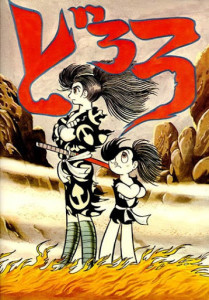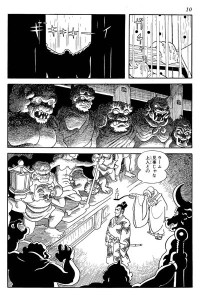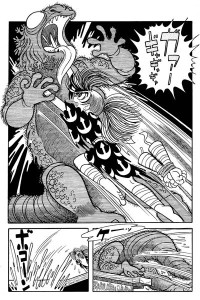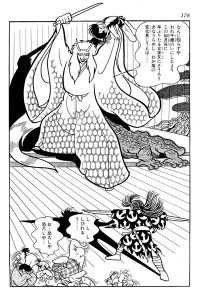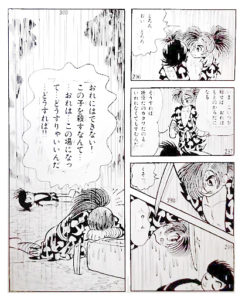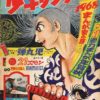Dororo (Manga)
Also known as どろろ (Dororo)
| English Title: | Dororo |
| In English? | Yes |
| Japanese Title: | どろろ Dororo |
| Type: | Ongoing Serial |
| Original run: Second run: |
1967/08/27 – 1968/07/21 1969/05/01 – 1969/10/01 |
| Published in: | Weekly Shonen Sunday 週刊少年サンデー Adventure King 冒険王 |
| Published by: | Shogakukan Akita Shoten |
| Volumes: | 4 |
Tezuka’s signature samurai series, Dororo (1967-69) was originally published in Weekly Shonen Sunday from August 1967 to July 1968. After a hiatus, the manga series concluded its run in Adventure King from May to October 1969 to coincide with the release of the animated television show.
What it’s about
Set during the Sengoku or “Warring States” period in Japanese history, Dororo (1967-69) is the tale of a demon-hunting ronin, Hyakkimaru, and his young thief side-kick, Dororo.
The story begins with the daimyo Daigo Kagemitsu forging a pact with 48 demons – promising each of them a piece of his unborn son in exchange for power to rule over the land. As such, his son is born a malformed, limbless, faceless creature. Aghast at the monstrosity, Kagemitsu orders the child destroyed and his mother sets the child adrift on a river where it is eventually found and raised by the kindly Jukai, a rural doctor. Using his healing arts, Jukai replaces the child’s missing body parts with prosthetics crafted out of wood and ceramics.
As the seasons come and go, and the child eventually grows into a young man, the doctor begins to notice that the boy holds a strange attraction for demonic spirits – to the point where his house is becoming overrun with them. As such, Jukai decides it is time for him to strike out on his own, to travel the world in search of acceptance. However, before he leaves, Jukai gave his surrogate son two gifts – the first is to perform an operation grafting a special blade onto his left arm, and the second is to finally give him the name Hyakkimaru (百鬼丸), literally meaning “One Hundred Demons”.
Soon after leaving home Hyakkimaru, learns that by killing the demons responsible for his condition, he can reclaim his missing body parts and thus restore his humanity. And so, one by one, Hyakkimaru began to hunt down the demons. Along the way he crosses paths with a young orphaned thief named Dororo. Despite Dororo‘s fearless “devil may care” attitude, the two establish a strong bond and travel side by side across the war-torn countryside in search of adventure.
What you should know
Set during the warring-states period of Japan, Dororo (1967-69) is Tezuka’s contribution to the yōkai genre of storytelling – and is more or less a direct response to the sudden burst of popularity the genre received by the works of Shigeru Mizuki in the mid-1960’s.
In Dororo (1967-69), Tezuka combines supernatural monster designs, influenced by traditional Japanese prints and theatre, with much more mature and detailed natural background scenes than appear in most of his earlier work. Through his creative use of Japanese folklore and ghost stories it has become a major work in Tezuka’s corpus – setting the standard for many of the samurai adventure stories that followed it.
Much like Vampires (1966-69), Dororo (1967-69) is part of a transitional period in Tezuka’s growth as a storyteller. Although the bright child thief Dororo was originally intended to be the star of the manga, the dark, vengeful anti-hero Hyakkimaru proved even more popular. It was this display of his fans’ willingness to accept adults as the stars of their manga instead of the traditional boy heroes that opened the door for Tezuka’s more mature later works. So it is perhaps unsurprising that the pairing of Hyakkimaru and Dororo is often considered to be the protogenetic version of the later duo Black Jack and Pinoko.
According to Tezuka in the postscript to the Osamu Tezuka Complete Manga Works edition (MT-150), Dororo (1967-69) is a “story of karma, that is to say the repercussions and consequences assumed by a character for a crime committed by a member of his family before his birth” (1981, p. 237). As such, Tezuka initially began the story with a lot of interest in the project. However, as the series went on and Tezuka began to show the suffering of the oppressed peasant class during the warring states period, it became darker and darker in tone. Just as Tezuka felt the realism was becoming too much for a shonen periodical, the opportunity to start the ambitious sci-fi series Noman (1968) came up with a different publisher, and Tezuka’s enthusiasm dropped substantially. Ultimately, at the request of the editor, he suspended publication of Dororo (1967-69), leaving the series with no real ending.
Luckily, when the Dororo (1969) animated television show began airing in 1969, and with Noman (1968) having already concluded, Tezuka had an opportunity to return to the series. And so, with the May 1969 issue of Adventure King, the series returned, but with one significant difference. For the “reboot” Tezuka decided to introduce a new set-up for the series – that Hyakkimaru‘s lost/sacrificed 48 body parts were in fact used to create a human… and that human was none other than Dororo!
This new set of circumstances created a new dilemma for Hyakkimaru. Instead of having to defeat the 48 demons individually, if he wanted to quickly regain his true body he could do so simply by killing Dororo. Of course, despite being sorely tempted, he couldn’t bring himself to do it. However, despite the ramp up in dramatic tension the new set-up created, it was later ultimately abandoned when the series was later re-edited into book format.
Unfortunately though, viewership levels for the animated television show began to slide (likely at least partially due to the fact the series was in B&W rather than more “modern” colour) and the manga series suffered as a result and was once again cancelled… this time for good.
Although he had originally intended the story to show Hyakkimaru battling 48 different demons and recovering his body parts one by one, because of the editorial request to end the series, he made what he would later refer to as a “silly” decision to depict Nue, a monster that was a combination of all of the remaining demons, as a way to finish series off quickly. Regardless, the series came to a close for the second and final time with the October 1969 issue of Adventure King.
Although some readers will be frustrated by the obviously rushed ending of the manga, most will still find themselves deeply engaged in the gradual development of the relationship between Dororo and Hyakkimaru.
In fact, Tezuka himself would later recall a moment at the 1980 San Diego Comic Convention when a fan girl exclaimed “I love him!” after he drew a sketch of Hyakkimaru for her – one of several American youths who told him Dororo (1967-69) was their favourite story by him. Of course this all happened long after Dororo (1967-69) had ended due to lack of popularity, so those responses made him happy but the overall experience felt strange.
Finally, according to Tezuka himself, he got the title for Dororo (1967-69) from a child (exactly which one is up for debate – either one of his or one of his friend’s) mispronouncing the Japanese word for “thief/robber”, dorobou <どろぼう>.
Where you can get it
Luckily for English-speaking fans, Dororo (1967-69) was published by Vertical Inc. in 2008. Originally released as three separate paperback volumes, in 2012, Vertical Inc. republished Dororo (1967-69) as an all-in-one omnibus edition.
What else you should check out
Check out the link below for chapter summaries and more detailed publication information on the Dororo (1967-69) serialization in Weekly Shonen Sunday and Adventure King.

